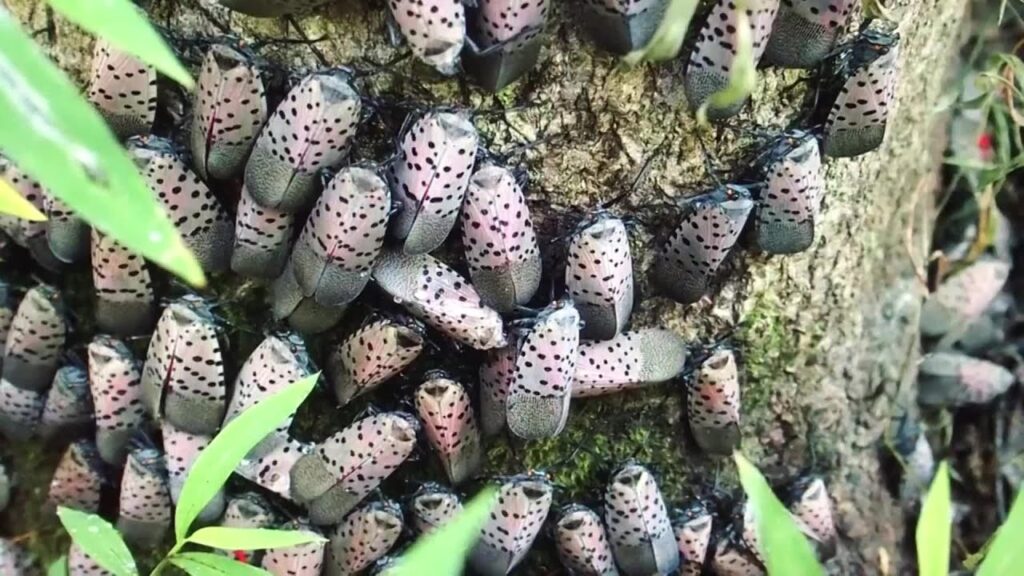We have a bad bug that’s reached our state’s borders. The spotted lanternfly is beautiful in its five stages of growth. But the adult spotted lanternfly (Lycorma delicatula) is a pest that is deadly to plants. Insects appear in such great numbers they suck the life out of plants.

Spotted lanternfly was first detected in Pennsylvania in 2014. The bug originates in China, where it’s considered a pest. It’s also a pest in Japan, South Korea, India, Vietnam, Taiwan and now North America.
A gardener’s experience with spotted lantern fly
The morning I talked to her by phone, Louise Clarke had been out looking for signs of spotted lanternfly in her Pennsylvania garden, Halcyon. A horticulturist and certified arborist, Louise found the fourth instars in her landscape.

“I was also out looking for egg masses,” said Louise, a fellow member of GardenComm. The insect lays eggs mostly on smooth surfaces, which can be a maple tree trunk, lawn furniture or wheel wells on vehicles. The mass, which looks like a smear of mud, contains 30 to 50 eggs. Add to that moving firewood that could have egg masses and you’ve got an idea of how they get around.
The egg mass is easy to scrap off when you can reach it, Louise said. The eggs hatch and the insects fall to the ground. They they begin their tree climbing assault as they go through their growth cycles. Many times, the mass (and the insects) will be too far up in a tree to reach safely.

They don’t fly, they hop
Despite their name, these insects are not flies. They are leaf hoppers and are terrible at flying, Louise said. “They hop in sort of an arching pattern and that makes it hard to catch and smash them.”

What is the spotted lantern fly so bad?
Do you like wine? What about peaches and other stone fruits? Black walnuts? Maples, birches, willows and other trees? Spotted lanternfly likes 70 different plant species. The feeding zaps the plants, weakening and stressing them, making them susceptible to disease and other insect problems, and possibly death.
Its favorite host plant is tree of heaven (Ailanthus altissima), something we don’t want in our landscape anyway. How many of this tree from China are growing in just your neighborhood, let along on vacant lots, alleyways and roadsides?
Let’s just look at Indiana’s wine industry, as an example. The total economic impact is $603 million, according to 2018 figures from the Indiana Wine Grape Council, the most recent available. Add to that the economic contributions of stone fruits like plum, apricot and peach and the losses begin to rise. Multiply that by the number of states that have reported the insect and the damage goes way beyond a farmer’s income. State and federal taxes also would be affected, compounding the loss of revenue. It doesn’t seem unreasonable to put damage from spotted lanternfly into the billions.

Spotted lantern fly damage doesn’t stop there
As the insects use their piercing, sucking mouth parts to deplete nutrients from plants, they emit a substance called honeydew. Besides adhering to branches, twigs and bark, sticky honeydew drips onto whatever is below – plants, furniture, heads. The honeydew feeds the growth of a black, sooty mold. Although the mold is harmless to humans, it damages the plants by discoloration and coating the leaves. It’s also very hard to get off furniture, swing sets, cars and other equipment or fixtures. Who wants to be outside with honeydew dripping on them? Or the bugs hopping around them?
We’re not just talking about a few dozen spotted lanternfly. We’re talking hundreds, maybe thousands of the insects hopping about. Penn State and Pennsylvania’s DNR have developed management techniques and there are many on YouTube.
What to do?
- Regularly monitor your garden for all stages of the spotted lanternfly. The adults are about 1 inch long. In the early stages of development, the insect is only about 1/8 inch long.
- Routinely check lawn furniture, sides of buildings, wheel wells, firewood and other smooth surfaces for the egg masses of spotted lanternfly. Scrape the egg mass away.
- Save a sample to show DNR officials but kill the rest.
Meanwhile, back at home, please report any suspected finds to the Indiana Department of Natural Resources. Call 866-NO EXOTIC (866-663-9684) or email DEPP@dnr.IN.gov. Please leave your name, contact number and detailed information about what you are reporting. Photos are always appreciated. By notifying DNR of a potential pest problem you provide an invaluable service to the DNR and our natural resources.